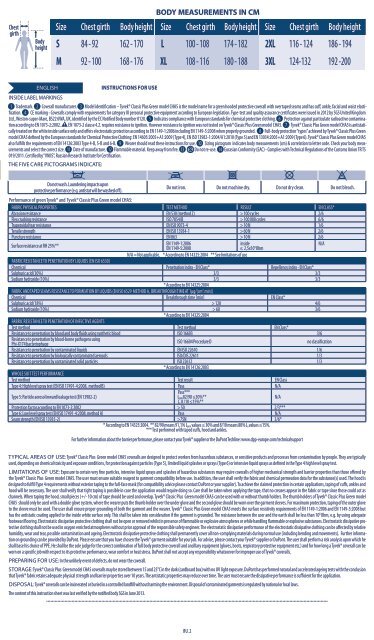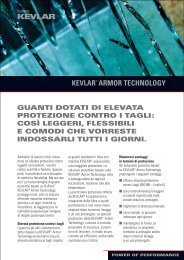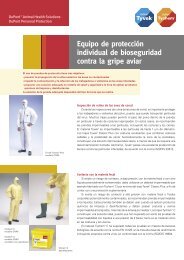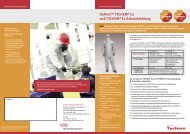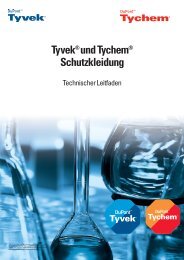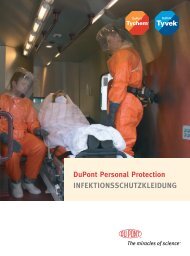DPN09270-62 - Tyvek - IFU (June 22sd, 2012) - Client copy
DPN09270-62 - Tyvek - IFU (June 22sd, 2012) - Client copy
DPN09270-62 - Tyvek - IFU (June 22sd, 2012) - Client copy
You also want an ePaper? Increase the reach of your titles
YUMPU automatically turns print PDFs into web optimized ePapers that Google loves.
Chest<br />
girth<br />
Body<br />
height<br />
BODY MEASUREMENTS IN CM<br />
Size Chest girth Body height Size Chest girth Body height Size Chest girth Body height<br />
S 84 - 92 1<strong>62</strong> - 170 L 100 - 108 174 - 182 2XL 116 - 124 186 - 194<br />
M 92 - 100 168 - 176 XL 108 - 116 180 - 188 3XL 124-132 192 -200<br />
INSIDE LABEL MARKINGS<br />
ENGLISH INSTRUCTIONS FOR USE<br />
1 Trademark. 2 Coverall manufacturer. 3 Model identification – <strong>Tyvek</strong>® Classic Plus Green model CHA5 is the model name for a green hooded protective coverall with overtaped seams and has cuff, ankle, facial and waist elastification.<br />
4 CE marking - Coveralls comply with requirements for category III personal protective equipment according to European legislation. Type-test and quality assurance certificates were issued in <strong>2012</strong> by SGS United Kingdom<br />
Ltd., Weston-super-Mare, BS22 6WA, UK, identified by the EC Notified Body number 0120. 5 Indicates compliance with European standards for chemical protective clothing. 6 Protection against particulate radioactive contamination<br />
according to EN 1073-2:2002. EN 1073-2 clause 4.2. requires resistance to ignition. However resistance to ignition was not tested on <strong>Tyvek</strong>® Classic Plus Green model CHA5. 7 <strong>Tyvek</strong>® Classic Plus Green model CHA5 is antistatically<br />
treated on the white inside surface only and offers electrostatic protection according to EN 1149-1:2006 including EN 1149-5:2008 when properly grounded. 8 Full-body protection “types” achieved by <strong>Tyvek</strong>® Classic Plus Green<br />
model CHA5 defined by the European standards for Chemical Protective Clothing: EN 14605:2005+A1:2009 (Type 4), EN ISO 13982-1:2004/A1:2010 (Type 5) and EN 13034:2005+A1:2009 (Type 6). <strong>Tyvek</strong>® Classic Plus Green model CHA5<br />
also fulfills the requirements of EN 14126:2003 Type 4-B, 5-B and 6-B. 9 Wearer should read these instructions for use. 10 Sizing pictogram indicates body measurements (cm) & correlation to letter code. Check your body measurements<br />
and select the correct size. 11 Date of manufacture. 12 Flammable material. Keep away from fire. 13 2 Do not re-use. 14 Eurasian Conformity (EAC) - Complies with Technical Regulations of the Customs Union TR TS<br />
019/2011. Certified by “VNIIS”, Russian Research Institute for Certification.<br />
THE FIVE CARE PICTOGRAMS INDICATE:<br />
Do not wash. Laundering impacts upon<br />
protective performance (e.g. antistat will be washed off).<br />
Do not iron. Do not machine dry. Do not dry clean. Do not bleach.<br />
Performance of green <strong>Tyvek</strong>® and <strong>Tyvek</strong>® Classic Plus Green model CHA5:<br />
FABRIC PHYSICAL PROPERTIES TEST METHOD RESULT EN CLASS*<br />
Abrasion resistance EN 530 (method 2) > 100 cycles 2/6<br />
Flex cracking resistance ISO 7854/B > 100 000 cycles 6/6<br />
Trapezoidal tear resistance EN ISO 9073-4 > 10 N 1/6<br />
Tensile strength EN ISO 13934-1 > 60 N 2/6<br />
Puncture resistance EN 863 > 10 N 2/6<br />
Surface resistance at RH 25%**<br />
EN 1149-1:2006<br />
EN 1149-5:2008<br />
inside<br />
≤ 2,5x10 9 Ohm<br />
N/A<br />
N/A = Not applicable. * According to EN 14325:2004 ** See limitations of use<br />
FABRIC RESISTANCE TO PENETRATION BY LIQUIDS (EN ISO 6530)<br />
Chemical Penetration index - EN Class* Repellency index - EN Class*<br />
Sulphuric acid (30%) 3/3 3/3<br />
Sodium hydroxide (10%) 3/3 3/3<br />
* According to EN 14325:2004<br />
FABRIC AND TAPED SEAMS RESISTANCE TO PERMEATION BY LIQUIDS (EN ISO 6529 METHOD A, BREAKTHROUGH TIME AT 1μg/(cm 2 .min))<br />
Chemical Breakthrough time [min] EN Class*<br />
Sulphuric acid (18%) > 120 4/6<br />
Sodium hydroxide (10%) > 60 3/6<br />
* According to EN 14325:2004<br />
FABRIC RESISTANCE TO PENETRATION OF INFECTIVE AGENTS<br />
Test method Test method EN Class*<br />
Resistance to penetration by blood and body fluids using synthetic blood ISO 16603 3/6<br />
Resistance to penetration by blood-borne pathogens using<br />
Phi-X174 bacteriophage<br />
ISO 16604 Procedure D<br />
no classification<br />
Resistance to penetration by contaminated liquids EN ISO 22610 1/6<br />
Resistance to penetration by biologically contaminated aerosols ISO/DIS 22611 1/3<br />
Resistance to penetration by contaminated solid particles ISO 22612 1/3<br />
* According to EN 14126:2003<br />
WHOLE SUIT TEST PERFORMANCE<br />
Test method Test result EN Class<br />
Type 4: High level spray test (EN ISO 17491-4:2008, method B) Pass N/A<br />
Type 5: Particle aerosol inward leakage test (EN 13982-2)<br />
Pass***<br />
Ljnm82/90 ≤30%**<br />
N/A<br />
Ls 8 /10 ≤15%**<br />
Protection factor according to EN 1073-2:2002 > 50 2/3***<br />
Type 6: Low level spray test (EN ISO 17491-4:2008, method A) Pass N/A<br />
Seam strength (EN ISO 13935-2) >75N 3/6*<br />
* According to EN 14325:2004. ** 82/90 means 91,1% Ljnm values ≤ 30% and 8/10 means 80% Ls values ≤15%.<br />
*** Test performed with taped cuffs, hood and ankles.<br />
For further information about the barrier performance, please contact your <strong>Tyvek</strong>® supplier or the DuPont Techline: www.dpp-europe.com/technicalsupport<br />
TYPICAL AREAS OF USE: <strong>Tyvek</strong>® Classic Plus Green model CHA5 coveralls are designed to protect workers from hazardous substances, or sensitive products and processes from contamination by people. They are typically<br />
used, depending on chemical toxicity and exposure conditions, for protection against particles (Type 5), limited liquid splashes or sprays (Type 6) or intensive liquid sprays as defined in the Type 4 high level spray test.<br />
LIMITATIONS OF USE: Exposure to certain very fine particles, intensive liquid sprays and splashes of hazardous substances may require coveralls of higher mechanical strength and barrier properties than those offered by<br />
the <strong>Tyvek</strong>® Classic Plus Green model CHA5. The user must ensure suitable reagent to garment compatibility before use. In addition, the user shall verify the fabric and chemical permeation data for the substance(s) used. The hood is<br />
designed to fulfill Type 4 requirements without exterior taping to the full-face mask (for compatibility advice please contact DuPont or your supplier). To achieve the claimed protection in certain applications, taping of cuffs, ankles and<br />
hood will be necessary. The user shall verify that tight taping is possible in case the application would require doing so. Care shall be taken when applying the tape, that no creases appear in the fabric or tape since those could act as<br />
channels. When taping the hood, small pieces (+/- 10 cm) of tape should be used and overlap. <strong>Tyvek</strong>® Classic Plus Green model CHA5 can be used with or without thumb holders. The thumb holders of <strong>Tyvek</strong>® Classic Plus Green model<br />
CHA5 should only be used with a double glove system, where the wearer puts the thumb holder over the under glove and the second glove should be worn over the garment sleeves. For maximum protection, taping of the outer glove<br />
to the sleeve must be used. The user shall ensure proper grounding of both the garment and the wearer. <strong>Tyvek</strong>® Classic Plus Green model CHA5 meets the surface resistivity requirements of EN 1149-1:2006 and EN 1149-5:2008 but<br />
has the antistatic coating applied to the inside white surface only. This shall be taken into consideration if the garment is grounded. The resistance between the user and the earth shall be less than 10 8 Ohm, e.g. by using adequate<br />
footwear/flooring. Electrostatic dissipative protective clothing shall not be open or removed whilst in presence of flammable or explosive atmospheres or while handling flammable or explosive substances. Electrostatic dissipative protective<br />
clothing shall not be used in oxygen enriched atmospheres without prior approval of the responsible safety engineer. The electrostatic dissipative performance of the electrostatic dissipative clothing can be affected by relative<br />
humidity, wear and tear, possible contamination and ageing. Electrostatic dissipative protective clothing shall permanently cover all non-complying materials during normal use (including bending and movements). Further information<br />
on grounding can be provided by DuPont. Please ensure that you have chosen the <strong>Tyvek</strong>® garment suitable for your job. For advice, please contact your <strong>Tyvek</strong>® supplier or DuPont. The user shall perform a risk analysis upon which he<br />
shall base his choice of PPE. He shall be the sole judge for the correct combination of full body protective coverall and ancillary equipment (gloves, boots, respiratory protective equipment etc.) and for how long a <strong>Tyvek</strong>® coverall can be<br />
worn on a specific job with respect to its protective performance, wear comfort or heat stress. DuPont shall not accept any responsibility whatsoever for improper use of <strong>Tyvek</strong>® coveralls.<br />
PREPARING FOR USE: In the unlikely event of defects, do not wear the coverall.<br />
STORAGE: <strong>Tyvek</strong>® Classic Plus Green model CHA5 coveralls may be stored between 15 and 25°C in the dark (cardboard box) with no UV light exposure. DuPont has performed natural and accelerated ageing tests with the conclusion<br />
that <strong>Tyvek</strong>® fabric retains adequate physical strength and barrier properties over 10 years. The antistatic properties may reduce over time. The user must ensure the dissipative performance is sufficient for the application.<br />
DISPOSAL: <strong>Tyvek</strong>® coveralls can be incinerated or buried in a controlled landfill without harming the environment. Disposal of contaminated garments is regulated by national or local laws.<br />
The content of this instruction sheet was last verified by the notified body SGS in <strong>June</strong> 2013.<br />
<strong>IFU</strong> .2


